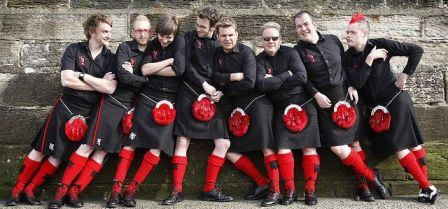The Red Hot Chilli Pipers
 Imagine the consternation: you’re anticipating the Red Hot Chili Peppers and then the curtain lifts and a bunch of bagpipers show up and begin playing. WTH? Yes, you’ve accidentally bought tickets to the Red Hot Chilli Pipers – and you aren’t the first person to make that mistake. Willie Armstrong, co-founder of the Pipers, laughs. “We’ve never had any trouble. The odd person buys a ticket for our show thinking that they’re going to see the Peppers, but even that is extremely rare.”
Imagine the consternation: you’re anticipating the Red Hot Chili Peppers and then the curtain lifts and a bunch of bagpipers show up and begin playing. WTH? Yes, you’ve accidentally bought tickets to the Red Hot Chilli Pipers – and you aren’t the first person to make that mistake. Willie Armstrong, co-founder of the Pipers, laughs. “We’ve never had any trouble. The odd person buys a ticket for our show thinking that they’re going to see the Peppers, but even that is extremely rare.”
Frankly, even if you were expecting the Peppers and ended up with the Pipers, it’s unlikely you or anyone else would be disappointed. The Chilli Pipers are becoming a force in their own right to be reckoned with: their Facebook page alone has 225,000 likes; more than a lot of popular groups, much less bagpipe bands. And the Pipers offer a rocking show with all manner of covers and self-penned traditional music.
Formed in 2004, the Pipers began as a band to play corporate functions. Armstrong put the group together with Stuart Cassells.
“We thought we would create a corporate bagpiping act that would include very tight piping and drumming,” Armstrong explains. “We had this idea that we would wear black kilts, black shirts and no sporrans and we would then play at corporate functions and generally have a good laugh. In the beginning we had to do a lot of gigs for free to see if it would catch on.”
The duo became a trio when Kevin MacDonald joined, but the band still lacked a name. Around that time, Cassells asked his girlfriend of the time to arrange all his CDs into order by genre. Looking through, he discovered the Red Hot Chili Peppers in the pile for traditional music and asked her why she’d placed them there. “I thought that it said Pipers,” she replied. And thus a band name was born.
Today, the group has 30 musicians who mix and match according to circumstances. The basic line-up is a kit drummer, a percussionist who plays marching snare, a keyboard player, a bass player, a lead guitarist and three pipers. Sometimes three brass players are added to boost the sound. The group also employs professional dancers and sound and lighting engineers.
“We can have a band on tour in the USA and a corporate band back in Scotland taking care of gigs here,” notes Armstrong. “We mix and match the players in the bands, so that the sound is maintained.”
The band has a new DVD, Live at the Lake, which made use of eight cameras for filming, including a rail camera in the pit. Armstrong says Insomnia begins the show with a long build-up and by the time the three pipers kick, the audience goes nuts. Another favourite is the Kings of Leon’s Use Somebody because it also incorporates the Strathspey Susan MacLeod. The piper says he loves the idea of playing a rock cover one moment and then switching to the Strathspey.
Armstrong, 49, is a firefighter who lives in Cumbernauld, between Glasgow and Edinburgh. He originally picked up piping from Donald Gibson at the Glasgow Skye Association Pipe Band in 1980, but then dropped it until 1995 while he was serving in the navy.
“At the age of 30 I was completely smitten by the sound in a much bigger way than I had been when I was younger,” Armstrong recalls. “I would practice for 12 hours a day and drove everyone to distraction.”
The practicing paid off. Last year the Pipers opened the main stage at T in the Park and had no less than the Kaiser Chiefs off in the wings, checking them out. Up next: a new studio recording.




















Leave a Comment